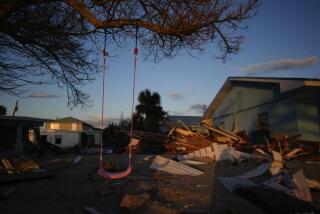Charley changes the faces of many area golf courses
All over Central Florida, the randomness of Hurricane Charley is evident in its aftermath. One home stands undisturbed while a neighbor’s house was hammered.
But there are other painful indications of Charley’s capriciousness. Brothers Bill and Tom Stine, who have operated golf courses for 25 years, own three courses in Charlotte Harbor. The city is located three miles from Punta Gorda, where the storm came ashore.
They also own two courses in Osceola County -- including Kissimmee Bay Country Club, which lost dozens of course-defining oak trees, sustained significant clubhouse damage and had a bridge washed out when the high winds passed over Friday.
“What are the odds? We own five course in the state, and the hurricane hit all five of them,” Tom said Wednesday.
Kissimmee Bay is one of several courses in Central Florida that remains closed as a result of hurricane damage, with the quiet hum of golf carts replaced by a cacophony of chain saws and backhoes as the owners try to clear the grounds and reopen their clubhouse doors.
In a lot of ways, the characteristics that make golf courses so pretty what make them susceptible to hurricanes and high wind -- lots of wide-open spaces surrounded by thick pockets of trees planted in well-irrigated ground. Virtually all of the estimated 150 courses in the region lost trees or sustained damage to their clubhouses, and many still are scrambling to get back in business.
Oddly, Kissimmee Bay sustained far worse damage than the trio of courses owned by the Stines near Punta Gorda. A stand of old-growth oak trees that defined the first three holes at Kissimmee Bay, a semi-private course, were savaged, he said.
“What are you supposed to do, replant them and wait 100 years for them to grow back?” Bill Stine said.
Like Kissimmee Bay, prestigious Lake Nona Golf and Country Club also is located in the storm’s direct path. Lake Nona, which is located adjacent to Orlando International Airport, felt sustained winds of 75 mph and suffered major tree damage. A gust of 105 mph was clocked Friday night at the airport.
The upscale home base to several of the biggest names in professional golf, it took a full day just to clear away the trees blocking the entrance to the enclave. The cleanup will take a minimum of 10 days, and officials say they fear the aesthetics and design of the course have been affected significantly.
“The tree damage, it’s just devastating,” said Gregor Jamieson, Lake Nona’s director of golf. “We’ve lost a lot of character trees, ones that were intentionally left behind when the course was built, that will be very hard to replace.”
Jamieson said that workers haven’t been able to mow the fairways, and there also is mounting concern regarding the course’s subsurface drainage and irrigation systems, which appear to have been damaged by falling trees or silt congestion. Jamieson estimates the development lost more than 1,000 trees and that the course’s tally alone “is in the high hundreds.”
Resident and former PGA Tour pro Frank Nobilo, now a Golf Channel commentator, was among those working feverishly with a chain saw to get the roads into the development cleared.
“The damage, right now, it’s hard to take it all in,” Jamieson said.
Joel Jackson of the Florida Golf Course Superintendents Association said some of the worst damage was reported in Winter Haven, where Lake Region Yacht and Country Club lost about 800 trees. Mountain Lake, a club in Lake Wales, sustained similar damage, and neither is expected to reopen for several weeks.
Tree damage is bad enough, but courses such as Lake Nona and Kissimmee Bay also face irrigation issues. Because of matters relating to electricity or the lack of drainage, the courses are not being watered, which fast will become a problem if it stops raining and the course dries out.
Orlando’s Rio Pinar Country Club, a former PGA Tour site the name of which translates into “river of pines” in Spanish, also was spanked, losing an estimated 300 trees. Employees were on the course all day Wednesday on clean-up detail, and the course won’t re-open until next week.
With 99 holes of golf, Disney World has the greatest acreage in the area, but the resort was only nicked by the storm, relatively speaking. Lee Rawls, Disney’s director of golf, said the resort lost roughly 200 trees on each course, but few that should affect playability. The courses reopened Sunday. Disney hosts a PGA Tour event in October.
“I think we were very, very fortunate that we were right on the edge of the storm,” Rawls said.
The storm was hard on bargain-priced courses. Historic Dubsdread Golf Course in College Park, the closest thing to a municipal course in Orlando, lost several key trees, including an old oak on the 16th hole. The back nine won’t reopen until Saturday.
Bay Hill reopened nine holes Wednesday, and officials say they hope to have the rest of the 27-hole facility reopened by Friday.
Steve Elling can be reached at selling@orlandosentinel.com.
More to Read
Sign up for Essential California
The most important California stories and recommendations in your inbox every morning.
You may occasionally receive promotional content from the Los Angeles Times.










